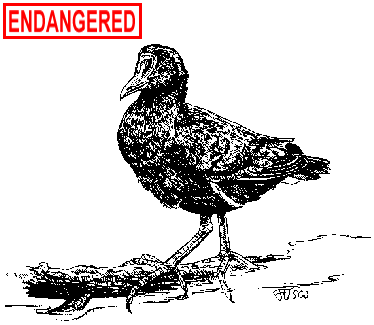Common Moorhen 
Gallinula chloropus
Habitat: Fresh water marshes with emergent vegetation and pools or ditches of open water.
Weight: 14 ounces.
Length: 12-15 inches.
Wingspan: 20-23 inches.
Life Expectancy: Banding indicates 5-6 years of age.
Food: Aquatic vegetation, seeds, grasses, snails, worms and insects.
Status: State endangered.
Identification: The common moorhen is a uniformly gray, duck-like bird with a short, red bill tipped with yellow. A line of white feathers on the flanks and the red bill distinguish the moorhen from the similar-looking coot. Like the coot, the common moorhen pumps its head back and forth while swimming. Sexes are similar, but the male tends to be larger.
Range: The moorhen is found on all continents, except Australia and Antarctica, wherever there is suitable habitat. In the eastern United States, New England represents the northern extreme of the species' nesting range. Populations winter from the southern Atlantic states to South America.
Reproduction: From April to early May, the common moorhen arrives on northern parts of its breeding range. The nest is a well-rimmed cup constructed of dead vegetation and lined with grass. It is usually located over water and anchored to the stems of bushes; occasionally, the nest is on the ground or in a low shrub. Water depth around the nest usually ranges from 1 to 3 feet. Both sexes share in nest building, incubation and care of the young. The 8 to 10 eggs are cinnamon to olive-buff and spotted with various shades of browns. Incubation begins with the laying of the first egg and lasts for 18 to 21 days. There may be up to 4 days between hatching of the first and last egg. The young leave the nest soon after hatching and are able to take care of themselves at an early age. The moorhen sometimes nests in small colonies.
Reason for Decline: Degradation and loss of deep water marshes with emergent vegetation are the greatest threats to Connecticut’s moorhen populations. Much of this habitat loss is associated with the draining and filling of wetland areas for urban/suburban development. The popularity of Connecticut's aquatic resources for recreation has also contributed to the decline of the wetland areas used by the moorhen.
History in Connecticut: The moorhen was considered a common summer resident in the late 1800s and early 1900s. It was most abundant along coastal areas, where it utilized both brackish and freshwater marshes. Moorhens are currently rare summer visitors and are only accidental during the winter months. The population decrease in Connecticut could be related to a decline throughout the moorhen’s range.
Interesting Facts: This species is more common in other parts of its range, and many states have federally-regulated hunting seasons.
The moorhen is a good swimmer and diver but has long-toed, unwebbed feet. These large, chicken-like feet enable it to walk on floating vegetation and climb through dense clumps of emergent vegetation. The moorhen often dives to feed or to escape enemies. It rarely flies, but when forced to, it flutters away, barely skimming the water, half running, half flying along the surface, then it suddenly drops into the marsh. When flying from pond to pond, flight is strong and direct.
Pairs give loud, hen-like squeaks, clucks, screams and a single, explosive, frog-like "kup."
The common moorhen is also known as the American gallinule. Gallinule, which is Latin for "chicken-like," describes the way moorhens walk and peck at food along the water's edge. In some locales, the moorhen is known as the blue rail, chicken-foot coot, red-billed mud hen and Florida gallinule.
Protective Legislation: Federal - Migratory Bird Treaty Act of 1918; federal migratory game bird hunting regulations. State - Connecticut General Statutes Sec. 26-311; migratory game bird statutes, Connecticut General Statutes Sec. 26-91.
What You Can Do: Support for strong wetland protection legislation and zoning regulations will help maintain existing moorhen habitats. In some areas, wetland reclamation projects and waterfowl habitat management programs can create "new" areas suitable for moorhen use.

The production of this Endangered and Threatened Species Fact Sheet
Series is made possible by donations to the Endangered Species-Wildlife Income Tax
Checkoff Fund.
(rev. 12/99)

